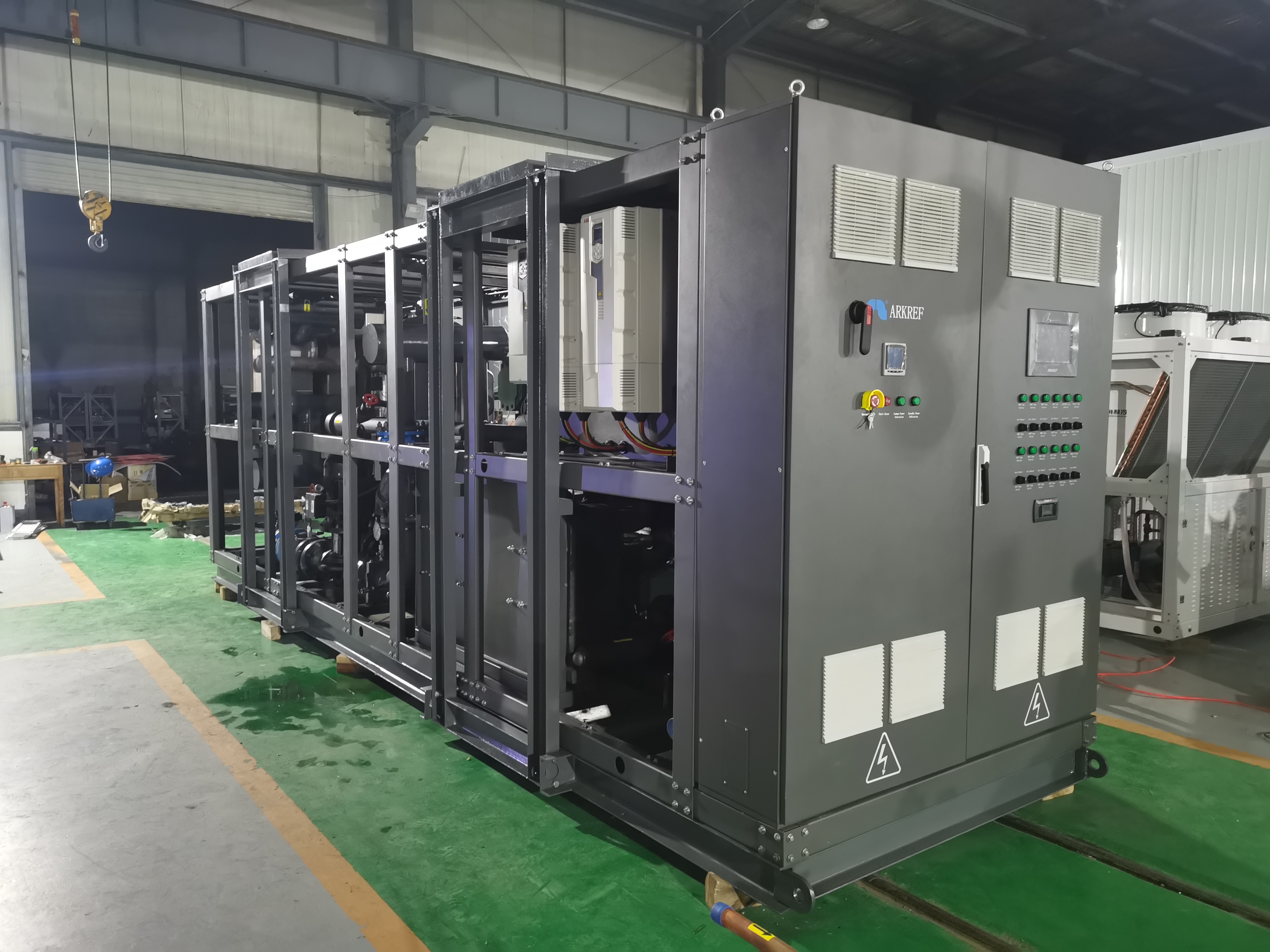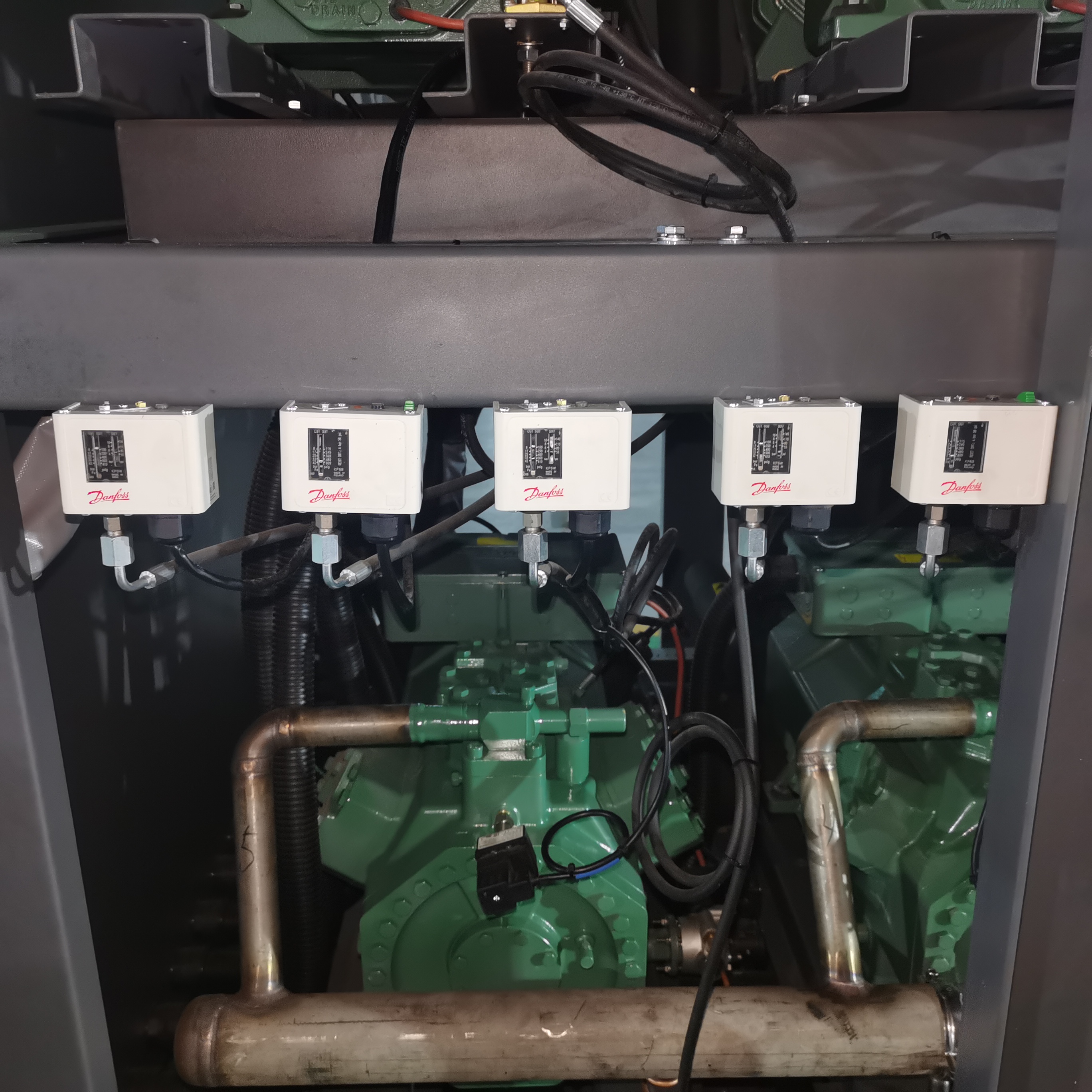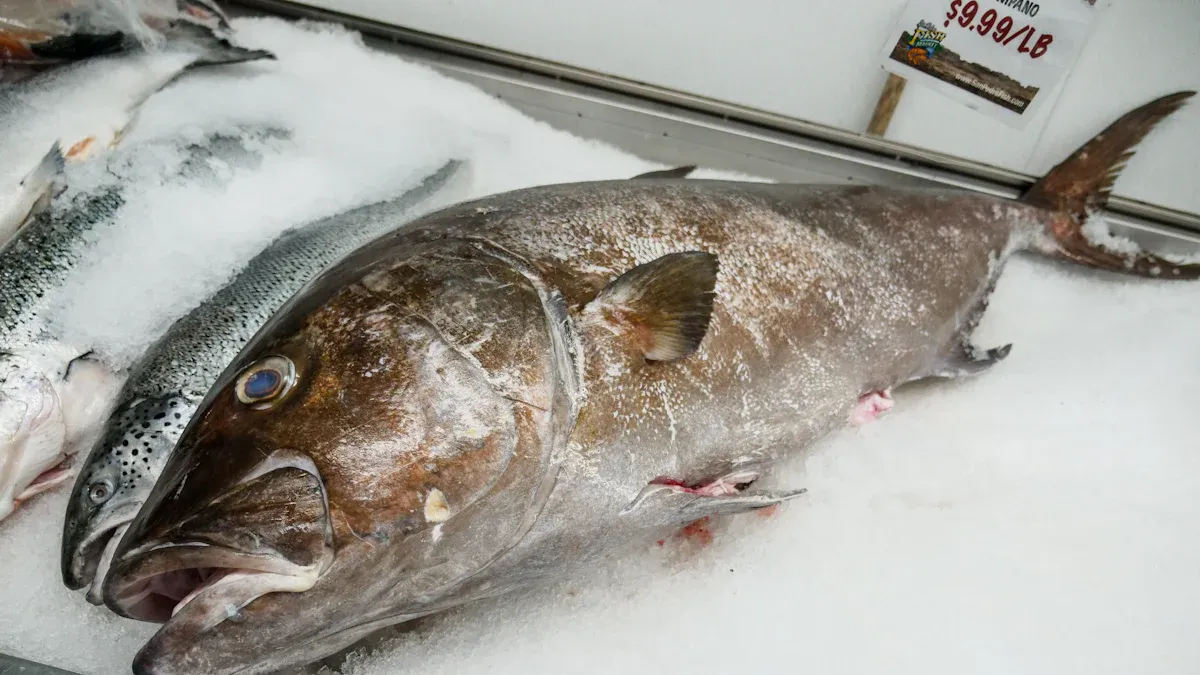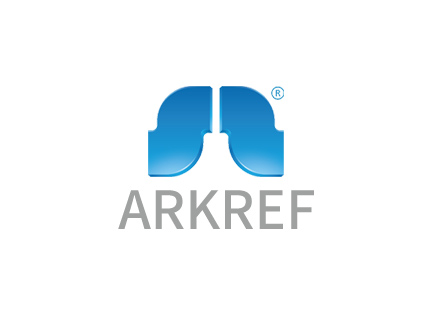How Tunnel Freezers Save Seafood Quality Fast

Have you ever wondered how seafood stays fresh from the ocean to your plate? A tunnel freezer for seafood is the secret weapon. It freezes seafood quickly, locking in its natural texture, flavor, and nutrients. Without advanced freezing methods, seafood can spoil in just two days. In fact, a study shows that 69.4% of seafood handlers don’t use any preservation treatment, leading to significant waste:
Statistic Description | Value |
|---|---|
Maximum storage time for fish | 2 days |
Percentage of respondents reporting 2-day storage | 12.5% |
Percentage of respondents using salt for preservation | 30.6% |
Percentage of respondents not applying any treatment | 69.4% |
Tunnel freezers ensure seafood stays fresh longer, reducing spoilage and waste.
What Is a Tunnel Freezer for Seafood?
Definition and Purpose
A tunnel freezer for seafood is a specialized freezing system designed to preserve seafood by rapidly lowering its temperature. Unlike traditional freezers, it uses a controlled environment to freeze products quickly and evenly. This process prevents the formation of large ice crystals, which can damage the delicate texture of seafood. By freezing seafood in minutes instead of hours, tunnel freezers help maintain its natural flavor, texture, and nutritional value.
These freezers are essential for seafood processors who need to handle large volumes efficiently. They ensure that seafood stays fresh and high-quality, even during long storage or transportation. Whether you're freezing fish fillets, shrimp, or shellfish, a tunnel freezer provides the speed and precision needed to meet industry standards.
Types of Tunnel Freezers
Not all tunnel freezers are the same. Different types cater to various seafood processing needs:
Spiral Tunnel Freezers: Ideal for high-capacity production lines, these freezers use a spiral conveyor system to maximize space and efficiency.
Cryogenic Tunnel Freezers: These use liquid nitrogen or carbon dioxide for ultra-fast freezing, perfect for delicate seafood like scallops or sushi-grade fish.
IQF Tunnel Freezers: "Individually Quick Frozen" freezers are designed to freeze each piece of seafood separately, preventing clumping and ensuring even freezing.
Each type offers unique advantages, but all share the goal of preserving seafood quality through rapid and uniform freezing.
Importance in the Seafood Industry
In the seafood industry, freshness is everything. Tunnel freezers play a critical role in maintaining that freshness. By freezing seafood quickly, they prevent spoilage and reduce waste. This is especially important for global supply chains, where seafood travels long distances before reaching consumers.
Rapid freezing also helps seafood retain its natural texture and flavor. For example, fish frozen in a tunnel freezer tastes almost as fresh as the day it was caught. Additionally, these freezers support large-scale operations by offering continuous production capabilities. This means seafood processors can meet high demand without compromising quality.
In short, tunnel freezers are a game-changer for the seafood industry. They ensure that the seafood you enjoy is as fresh, flavorful, and nutritious as possible.
How Tunnel Freezers Work

The Freezing Process
Role of Airflow
Airflow plays a huge role in how a tunnel freezer for seafood operates. High-speed air circulation ensures that cold air reaches every part of the seafood. This uniform airflow prevents uneven freezing, which could lead to quality issues. Imagine a powerful fan blowing chilled air over seafood as it moves through the tunnel. This process not only speeds up freezing but also helps maintain the seafood's natural texture and taste.
Temperature Control Mechanisms
Precise temperature control is another key feature of tunnel freezers. These systems use advanced mechanisms to keep the temperature consistently low throughout the freezing process. Pre-cooling is often used to lower the seafood's temperature before it enters the main freezing zone. This step minimizes dehydration and ensures the seafood freezes quickly and evenly. By maintaining strict temperature control, tunnel freezers prevent damage to the seafood's cells and tissues, preserving its quality.
Speed and Efficiency
Tunnel freezers are all about speed and efficiency. Unlike traditional methods, which can take hours, these freezers can freeze seafood in minutes. This rapid process prevents the formation of large ice crystals, which can ruin the texture of seafood. Each piece of seafood is frozen individually, ensuring it retains its natural appearance and flavor. The speed of freezing also reduces the risk of spoilage, making tunnel freezers a reliable choice for large-scale seafood processing.
Preventing Ice Crystal Formation
One of the biggest advantages of tunnel freezers is their ability to prevent large ice crystals from forming. When seafood freezes slowly, large crystals can develop, damaging its cellular structure. Tunnel freezers use rapid freezing techniques, like cryogenic cooling with liquid nitrogen or dry ice, to avoid this issue. By freezing seafood quickly, these systems preserve its taste, texture, and nutritional value. The result? Seafood that looks and tastes as fresh as the day it was caught.
Benefits of Tunnel Freezers for Seafood

Preserving Texture and Flavor
Have you ever noticed how some frozen seafood tastes bland or feels mushy? That’s because traditional freezing methods often allow large ice crystals to form, damaging the delicate structure of seafood. A tunnel freezer for seafood solves this problem by freezing each piece rapidly and evenly. This process locks in the natural texture and flavor, so your seafood tastes as fresh as the day it was caught.
IQF tunnel freezers are especially effective at maintaining quality. They prevent large ice crystals from forming, which helps seafood retain its natural appearance and taste.
The rapid freezing process minimizes damage to delicate items like shrimp or scallops, ensuring they stay firm and flavorful.
With tunnel freezers, you can enjoy seafood that looks and tastes just like it came straight from the ocean.
Maintaining Nutritional Value
Seafood is packed with nutrients like omega-3 fatty acids, vitamins, and minerals. But slow freezing can cause nutrient loss, leaving you with less healthy meals. Tunnel freezers use advanced technology to freeze seafood quickly, locking in its nutritional value.
Individual freezing ensures that each piece of seafood retains its nutrients. This is crucial for preserving fresh products and maintaining their integrity.
By freezing seafood rapidly, tunnel freezers prevent cellular damage, which helps keep those essential nutrients intact.
When you choose seafood frozen in a tunnel freezer, you’re not just getting great taste—you’re also getting all the health benefits seafood has to offer.
Extending Shelf Life
Nobody likes wasting food, especially when it’s as valuable as seafood. Tunnel freezers extend the shelf life of seafood by freezing it quickly and effectively. This reduces spoilage and ensures that seafood stays fresh for longer periods.
Rapid freezing prevents the growth of bacteria and other microorganisms that cause spoilage.
With a longer shelf life, seafood processors can store and transport products more efficiently, reducing waste.
Thanks to tunnel freezers, you can enjoy high-quality seafood without worrying about it going bad too soon.
Reducing Waste and Spoilage
Seafood spoilage is a major challenge, but tunnel freezers can help you tackle it head-on. By freezing seafood quickly, these systems prevent the growth of bacteria and other microorganisms that cause spoilage. This means less waste and more high-quality seafood for you to enjoy.
One of the biggest advantages of tunnel freezers is their ability to maintain seafood freshness from processing to consumption. Rapid freezing locks in the natural taste, texture, and nutrients, ensuring the seafood stays in top condition. You’ll notice the difference when your seafood looks and tastes just as fresh as the day it was caught.
Here’s how tunnel freezers help reduce waste and spoilage:
They prevent large ice crystals from forming, which protects the cellular structure of seafood.
Precise freezing ensures uniform quality, so every piece meets high standards.
By minimizing spoilage, they support sustainability and reduce food waste.
Tunnel freezers also help you save money and resources. Their energy-efficient designs lower operational costs while reducing environmental impact. Plus, the rapid freezing process prevents freezer burn, which can ruin the flavor and texture of seafood. This means you get better quality products with less waste.
When seafood stays fresh longer, it benefits everyone. You get to enjoy delicious meals, and seafood processors can meet demand without throwing away spoiled products. Tunnel freezers make this possible by combining speed, precision, and efficiency. They’re not just a tool for freezing—they’re a solution for preserving seafood and protecting the planet.
With tunnel freezers, you can feel good knowing your seafood is fresh, sustainable, and waste-free. Isn’t that a win-win?
Tunnel Freezers vs. Traditional Freezing Methods
Freezing Speed Comparison
When it comes to freezing seafood, speed matters. Tunnel freezers excel in this area by freezing seafood in minutes, while traditional methods can take hours. This rapid process prevents spoilage and ensures seafood retains its natural qualities. Imagine a conveyor belt moving seafood through a tunnel where cold air circulates at high speeds. This setup freezes each piece quickly and evenly.
Traditional freezing methods, on the other hand, are much slower. They often result in uneven freezing, which can compromise the quality of seafood. The longer freezing time allows large ice crystals to form, damaging the delicate structure of seafood. Tunnel freezers eliminate this issue by freezing seafood individually and rapidly, preserving its texture and flavor.
Quality Retention
Tunnel freezers are a game-changer for preserving seafood quality. They use advanced technology to maintain the taste, texture, and nutritional value of seafood. By freezing seafood quickly, tunnel freezers prevent large ice crystals from forming. This is crucial for keeping the cellular structure intact.
IQF tunnel freezers ensure each piece of seafood retains its natural appearance and flavor.
Traditional methods often fail to preserve the delicate texture and flavor of seafood.
Innovative freezing technologies, like cryogenic freezing, improve the quality of frozen seafood while reducing environmental impact.
With tunnel freezers, you get seafood that looks and tastes as fresh as the day it was caught.
Energy Efficiency
Tunnel freezers are not just fast—they’re also energy-efficient. They use advanced insulation and refrigeration systems to minimize energy consumption. This efficiency translates to lower operational costs for seafood processors.
IQF tunnel freezers significantly reduce energy usage while maximizing freezing efficiency.
Modern designs include eco-friendly refrigerants like ammonia, which have a lower impact on the ozone layer.
Advanced control systems optimize operation, reducing wasted energy and supporting sustainability.
The IQF technology of OctoFrost is more environmentally friendly than traditional freezing methods. It uses natural gases like ammonia, which significantly decreases the impact on the ozone layer.
By choosing tunnel freezers, you’re not only preserving seafood quality but also protecting the environment.
Limitations of Traditional Methods
Traditional freezing methods might seem reliable, but they come with significant drawbacks that can affect the quality of your seafood. These methods often fail to preserve the delicate texture, flavor, and appearance that make seafood so appealing. Let’s take a closer look at why they fall short.
One major issue is the freezing speed. Methods like blast freezing take longer, allowing large ice crystals to form. These crystals can damage the seafood’s cellular structure, leaving it mushy or dry when thawed. Plate freezing, another common method, requires seafood to be packed into blocks. While this might sound efficient, it limits flexibility and can ruin the natural appearance of your seafood. Imagine trying to separate individual shrimp from a frozen block—it’s not ideal.
Here’s a quick breakdown of the limitations of traditional freezing methods:
Freezing Method | Limitations |
|---|---|
Blast Freezing | Slow freezing time can cause larger ice crystals, damaging texture and quality. |
Plate Freezing | Requires seafood to be packed in blocks, limiting flexibility and affecting appearance. |
Immersion Freezing | Rarely used due to cross-contamination risks and flavor changes. |
Brine Freezing | Alters natural taste, potentially making seafood salty or bitter. |
Cryogenic Freezing | Fastest method but expensive; extreme cold can damage delicate seafood texture. |
Some methods, like immersion or brine freezing, even alter the seafood’s flavor. You might notice a salty or bitter taste, which isn’t what you want in fresh seafood. Cryogenic freezing, while incredibly fast, can be costly and may harm the texture of delicate items like scallops.
These limitations highlight why traditional methods struggle to meet modern demands. If you’re looking for seafood that tastes fresh and retains its natural quality, traditional freezing just doesn’t cut it. Tunnel freezers, on the other hand, solve these problems with speed, precision, and efficiency. Why settle for less when you can have the best?
Applications of Tunnel Freezers in the Seafood Industry
Freezing Various Seafood Products
Fish and Fillets
Tunnel freezers are a game-changer when it comes to freezing fish and fillets. These systems ensure that each piece is frozen quickly and evenly, preserving its natural texture and taste. Whether it’s salmon, cod, or tuna, tunnel freezers prevent ice crystals from forming, which can damage the delicate structure of the fish. This is especially important for high-demand products like sushi-grade fish, where quality is non-negotiable.
You’ll also find that IQF (Individually Quick Frozen) tunnel freezers are particularly effective for fish fillets. They freeze each fillet separately, so you don’t have to deal with clumping or uneven freezing. This makes it easier to package, store, and transport fish while maintaining its freshness.
Shellfish and Crustaceans
Shellfish and crustaceans, like shrimp, lobster, and scallops, benefit immensely from tunnel freezing. These delicate seafood items require rapid freezing to retain their natural flavor and texture. Tunnel freezers use advanced airflow and temperature control to freeze shellfish without compromising their quality.
For example, cryogenic tunnel freezers are ideal for freezing scallops, as they lock in moisture and prevent freezer burn. This ensures that when you cook them, they taste just as fresh as they did when harvested. With the growing popularity of ready-to-eat seafood, tunnel freezers play a vital role in meeting consumer expectations for high-quality products.
Large-Scale Seafood Processing
If you’re in the seafood processing business, you know how important efficiency is. Tunnel freezers are designed for large-scale operations, allowing you to freeze massive quantities of seafood without sacrificing quality. Their continuous production line design ensures that seafood moves through the freezing process seamlessly.
Here’s why tunnel freezers are perfect for large-scale processing:
They freeze seafood rapidly, maintaining its taste and texture.
They prevent large ice crystals from forming, which can damage the food’s structure.
Each piece retains its natural appearance and flavor, meeting high industry standards.
By using tunnel freezers, you can handle high volumes of seafood while ensuring consistent quality. This makes them an essential tool for processors who need to meet growing demand without compromising on freshness.
Role in Global Supply Chains
Tunnel freezers are a cornerstone of the global seafood supply chain. They ensure that seafood stays fresh and high-quality, even during long-distance transportation. Rapid freezing minimizes ice crystal formation, extending the shelf life of seafood products. This is crucial for delivering fresh seafood to markets worldwide.
The growing demand for frozen seafood in international markets has made tunnel freezers indispensable. They help preserve the nutritional value and taste of seafood, ensuring that it reaches consumers in top condition. Innovations in freezing technology have also made these systems more energy-efficient, reducing costs for processors and supporting sustainability.
With tunnel freezers, you can trust that seafood will remain fresh from the moment it’s processed to the time it reaches your plate. That’s the kind of reliability the global seafood industry needs to thrive.
Tunnel freezers are a game-changer for preserving seafood quality. By rapidly freezing seafood, they prevent large ice crystals from forming, which helps maintain the natural texture, flavor, and nutrients. This is especially true for IQF tunnel freezers, which freeze items individually to lock in freshness and extend shelf life. You can count on these systems to deliver seafood that tastes just as fresh as the day it was caught.
Their efficiency makes them a superior choice for the seafood industry. Whether it’s shrimp, fish, or shellfish, tunnel freezers ensure products stay in top condition from processing to your plate. They’re not just about freezing—they’re about preserving quality and reducing waste. With their role in global supply chains, tunnel freezers help bring high-quality seafood to consumers worldwide.
See Also
The Advantages of Cryogenic Tunnel Freezers for Food Quality
Understanding the Major Advantages of Tunnel Freezers
Tunnel Freezer Technology: Solutions to Freezing Challenges
The Superiority of IQF Tunnel Freezers in Food Preservation
Blast Freezer Tunnel Settings: Protecting Your Food Effectively

